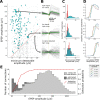Sparse recurrent excitatory connectivity in the microcircuit of the adult mouse and human cortex
- PMID: 30256194
- PMCID: PMC6158007
- DOI: 10.7554/eLife.37349
Sparse recurrent excitatory connectivity in the microcircuit of the adult mouse and human cortex
Abstract
Generating a comprehensive description of cortical networks requires a large-scale, systematic approach. To that end, we have begun a pipeline project using multipatch electrophysiology, supplemented with two-photon optogenetics, to characterize connectivity and synaptic signaling between classes of neurons in adult mouse primary visual cortex (V1) and human cortex. We focus on producing results detailed enough for the generation of computational models and enabling comparison with future studies. Here, we report our examination of intralaminar connectivity within each of several classes of excitatory neurons. We find that connections are sparse but present among all excitatory cell classes and layers we sampled, and that most mouse synapses exhibited short-term depression with similar dynamics. Synaptic signaling between a subset of layer 2/3 neurons, however, exhibited facilitation. These results contribute to a body of evidence describing recurrent excitatory connectivity as a conserved feature of cortical microcircuits.
Keywords: cortical wiring; electrophysiology; human; mouse; neuroscience; short term plasticity.
© 2018, Seeman et al.
Conflict of interest statement
SS, LC, PD, AH, TH, AB, CB, JL, SM, CT, AK, JO, RG, DS, CC, JP, EL, GM, CK, HZ, TJ No competing interests declared
Figures











Similar articles
-
Synaptic connectivity to L2/3 of primary visual cortex measured by two-photon optogenetic stimulation.Elife. 2022 Jan 21;11:e71103. doi: 10.7554/eLife.71103. Elife. 2022. PMID: 35060903 Free PMC article.
-
Primary visual cortex shows laminar-specific and balanced circuit organization of excitatory and inhibitory synaptic connectivity.J Physiol. 2016 Apr 1;594(7):1891-910. doi: 10.1113/JP271891. Epub 2016 Mar 11. J Physiol. 2016. PMID: 26844927 Free PMC article.
-
Role of GABAA-Mediated Inhibition and Functional Assortment of Synapses onto Individual Layer 4 Neurons in Regulating Plasticity Expression in Visual Cortex.PLoS One. 2016 Feb 3;11(2):e0147642. doi: 10.1371/journal.pone.0147642. eCollection 2016. PLoS One. 2016. PMID: 26841221 Free PMC article.
-
The age of plasticity: developmental regulation of synaptic plasticity in neocortical microcircuits.Prog Brain Res. 2008;169:211-23. doi: 10.1016/S0079-6123(07)00012-X. Prog Brain Res. 2008. PMID: 18394476 Review.
-
Synaptic Tenacity or Lack Thereof: Spontaneous Remodeling of Synapses.Trends Neurosci. 2018 Feb;41(2):89-99. doi: 10.1016/j.tins.2017.12.003. Epub 2017 Dec 21. Trends Neurosci. 2018. PMID: 29275902 Review.
Cited by
-
Composing recurrent spiking neural networks using locally-recurrent motifs and risk-mitigating architectural optimization.Front Neurosci. 2024 Jun 20;18:1412559. doi: 10.3389/fnins.2024.1412559. eCollection 2024. Front Neurosci. 2024. PMID: 38966757 Free PMC article.
-
Population codes enable learning from few examples by shaping inductive bias.Elife. 2022 Dec 16;11:e78606. doi: 10.7554/eLife.78606. Elife. 2022. PMID: 36524716 Free PMC article.
-
Harnessing the potential of human induced pluripotent stem cells, functional assays and machine learning for neurodevelopmental disorders.Front Neurosci. 2025 Jan 8;18:1524577. doi: 10.3389/fnins.2024.1524577. eCollection 2024. Front Neurosci. 2025. PMID: 39844857 Free PMC article. Review.
-
Scale-Free Dynamics in Animal Groups and Brain Networks.Front Syst Neurosci. 2021 Jan 20;14:591210. doi: 10.3389/fnsys.2020.591210. eCollection 2020. Front Syst Neurosci. 2021. PMID: 33551759 Free PMC article.
-
How deep is the brain? The shallow brain hypothesis.Nat Rev Neurosci. 2023 Dec;24(12):778-791. doi: 10.1038/s41583-023-00756-z. Epub 2023 Oct 27. Nat Rev Neurosci. 2023. PMID: 37891398 Review.
References
-
- Barth L, Burkhalter A, Callaway EM, Connors BW, Cauli B, DeFelipe J, Feldmeyer D, Freund T, Kawaguchi Y, Kisvarday Z, Kubota Y, McBain C, Oberlaender M, Rossier J, Rudy B, Staiger JF, Somogyi P, Tamas G, Yuste R. Comment on "Principles of connectivity among morphologically defined cell types in adult neocortex". Science. 2016;353:1108. doi: 10.1126/science.aaf5663. - DOI - PubMed
-
- Biane JS, Scanziani M, Tuszynski MH, Conner JM. Motor cortex maturation is associated with reductions in recurrent connectivity among functional subpopulations and increases in intrinsic excitability. Journal of Neuroscience. 2015;35:4719–4728. doi: 10.1523/JNEUROSCI.2792-14.2015. - DOI - PMC - PubMed
Publication types
MeSH terms
Grants and funding
LinkOut - more resources
Full Text Sources
Other Literature Sources

